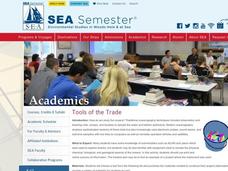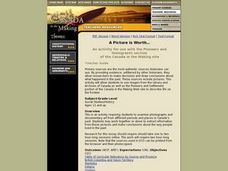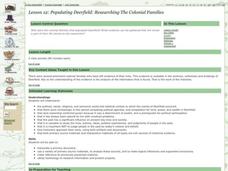Curated OER
This Guilty Land
Students investigate the actions and motives of John Brown. In this abolition lesson, students discover details about Brown's background as a free-state and abolition supporter. Students discuss his role as that of a martyr or terrorist....
Curated OER
Eyes of East Asia
There are many different cultural groups that dwell in East Asia. You and your special ed class will explore the East Asian culture by listing each culture group and then creating a collage style poster. They will attempt to identify...
Curated OER
Tools of the Trade
Students construct functional replicas of oceanographic tools and demonstrate and explain their use.
K20 LEARN
Diversity Quilt: A Lesson on Culture
After brainstorming the various aspects of cultural identity, class members interview each other, examine video clips, and read stories to discover how these aspects reveal one's cultural identity. Individuals then craft a quilt square...
Curated OER
What's for Dinner?
View a video presentation comparing chemosynthesis to photosynthesis. Review the findings of the 2004 Ring of Fire Expedition that studied biological communities around the hydrothermal vents of the Mariana Arc. In...
Curated OER
Rights and Responsibilities: Grass Born to Be Stepped On
Students research an event in history in which rights and responsibilities are involved. They create a movie of the information they find.
iCivics
Drafting Board: Electoral College
Should the president of the United States be voted by the Electoral College or the popular vote? Your young historians will consider the pros and cons of the Electoral College, and make an argument using reasons and evidence...
iCivics
Drafting Board: Community Service
Should schools impose community service graduation requirements? In the final lesson of the Drafting Board series, learners solidify their practice of crafting an argument supported by sound reason and evidence.
Curated OER
Men of Steel
Students explore early 20th century steel making. In this U.S. history steel making lesson plan, students view and describe a postcard and a picture depicting exaggerated aspects of the steel industry. Students listen to a...
Curated OER
The Finer Things in Life
Momoyama and Edo are periods in Japanese history that can be defined culturally and artistically. Learners explore and discuss how the samurai used sword guards and grip enhancers. Pupils read the story "The Inch-High Samurai," examine...
Curated OER
Structured Academic Controversy (SAC) in the History Classroom
SAC is a specific approach to discussing history and controversial issues. Rather than adhering to an either/or debate-style paradigm, it fosters speaking and constructivist listening to enable learners to build consensus through...
Alabama Learning Exchange
Bloodstain Pattern Doesn't Lie......
An interesting instructional activity on hypothesizing about the diameter of a drop of blood that is splattered. To test their theories, learners work in groups to make blood droplets splatter from different heights. They use graphed...
Maryland Department of Education
The Concept of Diversity in World Literature Lesson 13: Unit Culmination - Symposium
To conclude a unit on the concept of diversity in world literature, class members conduct a symposium on "African Literature in Global Perspectives." In order to earn a spot on the panel, individuals craft an original thesis that...
Described and Captioned Media Program
Malcolm X: Make It Plain, Part I
Malcolm X was a complicated man that few in white America understood. After sharing what they know or think they know about this civil rights leader, about nationalism and Black Nationalism, class members view a two-part documentary...
Curated OER
Geological Time Line
Students demonstrate knowledge of when coal was formed by plotting a geological time line.
Curated OER
A Picture is Worth...
Students use their photo analysis skills to gain an understanding of what pioneer life in Canada may have been like by examining historical photos. Students are then given an opportunity to present their findings to the class in a...
Curated OER
Plate, punch card, and instructions for Herman Hollerith's Electric Sorting and Tabulating Machine
Middle schoolers read an article and participate in a class discussion. In this technology and engineering lesson plan students conduct an online search for images and terms.
Curated OER
Populating Deerfield: A Workday for Researching the Colonial families
Eleventh graders explore who were the colonial families that populated Deerfield and what evidence can be gathered that reveals a part of their life stories to the researcher.
Curated OER
Abolition and the Underground Railroad in Essex County
Fifth graders investigate the end of slavery and the hidden paths slaves used to travel. In this U.S. history lesson, 5th graders examine the travel routes slaves used in Essex County known as the Underground Railroad....
Curated OER
A Line Drive
Eleventh graders create a 100 year timeline centering on the life of their research subject and place them in the context of local and national history.
Curated OER
Urbanization
Students examine the impact of urban change. In this Indiana history lesson plan, students read excerpts of The World Does Move by Booth Tarkington and then research the noted Web sites about the urbanization of Indianapolis. Students...
Curated OER
Causes of the American Revolution
Students access websites for background information and learn how to interpret political cartoons. They incorporate higher-order thinking skills to determine if the information presented in the cartoons is accurate, what the colonists...
Curated OER
Designing The Character Of Louisiana Purchase Louisianians
Students investigate the history of the Louisiana Purchase. They gather information using a digital library and internet resources. The information is used to construct a detailed summary of how the people of time lived. They also use...
Curated OER
Who Was Responsible for the Start of the Cold War?
Students determine who is responsible for the start of the Cold War. In this Cold War lesson, students conduct their own research about the evolution of the war and write essays that reveal their opinion on how the war began.

























